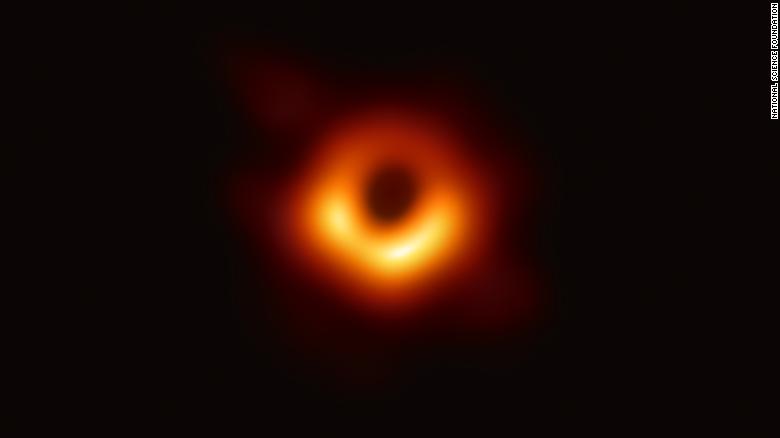Since the beginning of the human race, we have strived to discover and understand the unknown. The fascination with space can be dated all the way back to the ancient Greeks, Mayans, and many other civilizations who used stars and planets for navigation and in shaping their religion and mythology. As technology advanced, so did our understanding of the universe. One of the largest hurdles for space research was the introduction of the black hole. The theory of black holes was first introduced by Albert Einstein in 1915 in his general theory of relativity, and the first black hole to be spotted was in 1971. Since that year, research and speculation on what a black hole could actually look like has been endless, with many illustrations and simulations predicting the shape and appearance of the mysterious region of space. A black hole sucks up and traps all light due to extreme gravitational force, which makes them incredibly difficult to study. There are two black holes that have been the centerpiece of research and analysis in recent years. Sagittarius A* which lives right in our galaxy, the Milky Way, and another that lives about 55 million light years away in the heart of the constellation Virgo, in a galaxy called M87.
M87 is a blobby giant elliptical galaxy, and is home to the first ever photographed black hole. M87 is the most powerful source of radio energy known so far in the Virgo Cluster. The black hole at the center of this galaxy spews a bright jet of charged particles thousands of light years into space
In 2017, the Event Horizon Telescope took images of the central region of M87, where an asymmetrical ring of radio emissions surrounded the shadow of a supermassive black hole approximately six and a half billion times the mass of our Sun and 38 billion km across. With this information, the first ever photograph of a black hole was developed and released to the public on Wednesday, April 10th 2019.
Image taken by the Event Horizon Telescope (EHT) of the black hole within M87. The bright ring is a disk of gas orbiting the supermassive black hole. The ring is brighter on one side because the black hole is rotating, which means material on the side turning towards Earth has its emission boosted by the Doppler Effect. The dark centre is the black hole’s shadow, which is about five and a half times larger than the boundary marking the black hole’s limits, or the event horizon.
This image has been in the works for a long time, essentially from 2017 when the data was initially gathered, to 2019 when the image was released. “We’ve been studying black holes so long, sometimes it’s easy to forget that none of us have actually seen one,” director of the National Science Foundation, France Córdova said in the Washington, D.C., news conference.”(1) It is one of the most revolutionary achievements in recent years, as it lines up almost perfectly with what Einstein predicted the phenomenon to look like. Studies on general relativity in the past were done by looking at the movement of stars and gas clouds near the edge of the black hole, any closer and you are inside of it and can no longer report any findings. Although the image supports general relativity, some scientists believe that with more research, Einstein’s theory will quickly be contradicted, because it is incompatible with other physics theories such as quantum mechanics. The image has also opened doors for more analysis on the behaviour of black holes.
“With more data analysis, the team hopes to solve some long-standing mysteries about black holes. These include how M87’s black hole spews such a bright jet of charged particles many thousands of light-years into space.”(Grossman, Conover)
It’s hard to say what the outcome will be or how exactly this new discovery will change the physics field, but it is a major milestone in fully understanding the universe and its mysteries.
References
Britannica, The Editors of Encyclopaedia. “M87.” Encyclopædia Britannica, Encyclopædia Britannica, Inc., 10 Apr. 2019, www.britannica.com/place/Virgo-A.
Event Horizon Telescope Collaboration. “First Image of a Black Hole | NASA Solar System Exploration.” NASA, NASA, 10 Apr. 2019, solarsystem.nasa.gov/resources/2319/first-image-of-a-black-hole/.
Grossman, Lisa, and Emily Conover. “Here's the First Picture of a Black Hole.” Science News for Students, 22 Apr. 2019, www.sciencenewsforstudents.org/article/black-hole-first-photo-event-horizon-telescope.
Redd, Nola Taylor. “Black Holes: Facts, Theory & Definition.” Space.com, Future US Inc, 11 July 2019, www.space.com/15421-black-holes-facts-formation-discovery-sdcmp.html.
Tang, Yvonne. “The History of Astronomy.” Home - Curious About Astronomy? Ask an Astronomer, 17 Jan. 2015, curious.astro.cornell.edu/people-and-astronomy/the-history-of-astronomy.

No comments:
Post a Comment